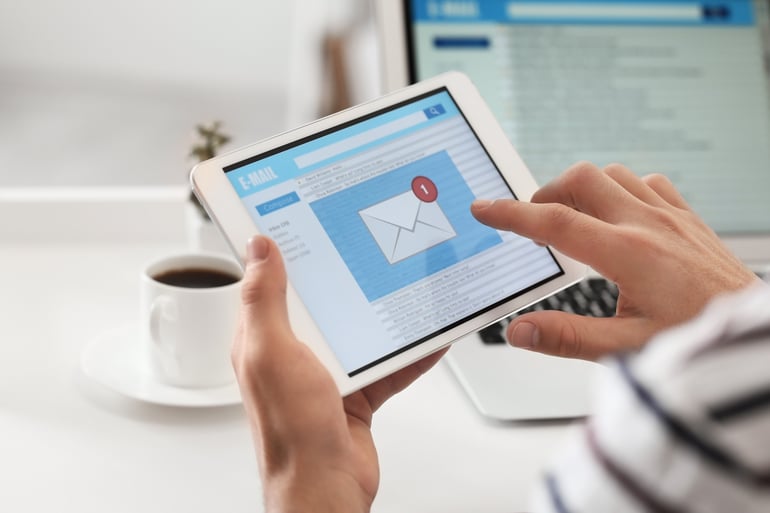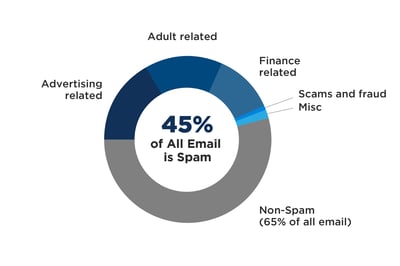 Email marketing remains one of the most impactful and cost-effective tools marketers have at their disposal. It's hard to believe, but the first email blast was sent way back in 1978. Still, it wasn't until the mid-2000s that marketing automation vendors such as HubSpot, Pardot, and Marketo dramatically raised the bar by evolving their technologies into unified sales and marketing solutions.
Email marketing remains one of the most impactful and cost-effective tools marketers have at their disposal. It's hard to believe, but the first email blast was sent way back in 1978. Still, it wasn't until the mid-2000s that marketing automation vendors such as HubSpot, Pardot, and Marketo dramatically raised the bar by evolving their technologies into unified sales and marketing solutions.
Since then, email marketing has become a dominant force in how the business world communicates.
In this article, we'll share our picks of best-practices to help maximize the results of your email marketing program. We will also discuss why email is such a crucial part of the marketing mix and how it has changed over time.
Why Email Marketing Matters and Recent Events
We realize most people reading this have used email marketing in their programs for years - however, there is always room to improve. With so many competing priorities, it's easy to lose focus on email fundamentals – but small improvements make a difference. If you haven't looked for ways to refine your email program lately, here are a few important reminders of why you should.
- Marketing automation leader Hubspot reported that by the end of 2020, marketing email volume on their platform was 50% higher than pre-COVID levels. With people working from home and relying on email more than ever before, it's not surprising.
- Studies have shown that anywhere from 75-89% of companies rely on email as the cornerstone of their marketing programs.
- According to Statista, in 2020, 4.03 billion people – roughly half of the world's population – had access to an email account. In the United States, 90.3% use email - 99% check it at least once a day - for 58%, it's the first thing they check when they wake up!
- For B2B businesses, email is the second most widely-used distribution channel, slightly behind but almost neck-and-neck with social media.
- In a recent DMA benchmark report, the average B2B email open rate across industries was 15.1%, with a click-through rate of 3.2% - even higher with the right audience and content. If you’re not impressed, compare these numbers and ROI with your other channels.
- Automation platforms offer a central hub to manage and track social media, digital advertising, and other channels, giving a full 360-degree view of the buying journey. Email has become the "glue" that ties together omnichannel strategies most marketers use today.

The Elephant in the Room
Let's quickly look at one of the major disruptions that most email marketers have faced in recent times – data privacy and email regulation. Specifically CAN-SPAM, CASL, and the GDPR. The latter two (and more recent ones) have much stricter rules with harsher penalties for noncompliance and have posed a severe challenge for some companies. 
While we marketers stress over the unfairness of it all, the fact of the matter is that spam remains a massive problem for companies and individuals. In 2019, roughly 45% of all email content was spam; this equates to about 14.5 billion spam emails sent every day worldwide. Unfortunately, the laws penalized not just the bad actors, but everyone regularly sending emails to large groups.
Changing the Game
For those who have experienced the onslaught of more restrictive email, you know it felt devastating at the time - and maybe it still hurts. With companies having invested so much into marketing automation platforms, it felt like being handcuffed in a hopeless situation.
So, what to do? Enter CONTENT MARKETING!
The goal started to become "quality over quantity," but the question was - how? Although not a new concept, "giving to get" gradually became the new mantra for most marketers. Companies began to understand the best way to attract, nurture, and engage new prospects was to add value through resources such as blogs, videos, podcasts, infographics, web tools, webinars, reports, and white papers.
The shift from sending a steady stream of "hard-sell" emails to offering information that can help people learn and do their jobs better has proven to be the best way to build virtual relationships with an audience of people who matter most. Content Marketing isn't an easy transition since creating content is time-consuming and costly – but the results have shown it works.
Sharing our Experience
Maria Ma, who is a Marketing Campaign Coordinator on our Operations team, shared, “Email is by far our most effective way of communicating information about our newly-released resources, upcoming webinars, and surveys to engineers. This has been consistent over the years, and it creates far more responsiveness and action than just waiting for our users to engage on their own.”
In sampling our current campaigns, an average of 78% of our engineering members download resources from promotional pushes through our email and newsletter programs. Analyzing sign-ups for webinars so far in 2021, we found an average of 80% registered for the events through our email channel.
Our clients understand and leverage email to engage engineers. During the first 2 months of this year, we have deployed 15 client campaigns to drive webinar/event registrations, 7 for product/service awareness initiatives, and 2 for resource sharing programs. A good percentage of Maria's time is spent managing our lists to maximize engagement while avoiding churn and fatigue through continual list segmentation and mixing up the content.

Our "Top 5" Areas of Focus for Success
Of course, there are literally hundreds of great ideas floating around on the Internet, but we have chosen five themes and a few supporting points we think have the most impact. (Hopefully, you agree). We suggest you take one focus area at a time, compare it to what you do now, and start improving.
Should you happen to have all of these nailed down already – congratulations! But for most, reminders are helpful, and marketing is rarely a "set it and forget it" function. Therefore, revisiting and refreshing may well be in order.
It's important to note that everything below will depend on how you use email in your business, and as always, the target audience!
#1 - Be Strategic and Holistic
You can't accomplish what you don't plan and manage.
One of the best pieces of advice we have is to become more strategic with your email program by looking at every aspect of it periodically. Marketers juggle so many things that it's easy to let this slip. But a series of small incremental improvements can have a massive impact.
Purpose and Goals: Step back and put some deep thought into what you are trying to accomplish with your program. The messaging and approach will be different for a single-use company update than a multi-touch campaign. When doing the latter, think about your workflows, campaign tracking, sales alignment, and integration with other channels. Determining, tracking, and learning from your metrics is also critical - but it’s a moot point if the data isn’t used to make improvements.
Stay Vigilant About Segmentation: You already know segmentation is a crucial tenet of your craft, so look for ways to continually get more information about your customers and prospects. Use personas, progressive profiling, pop-ups, and other features in your automation tool to create better-defined segments. The more you know about the people you want to engage, the more you can personalize your messaging and isolate user types to become more relevant. This article by B2B International may help.
Determine Your Frequency and Mix: Become thoughtful about how often you send emails to the same contacts and what the mix of content looks like over time. Do 3 of every 4 emails you send have obvious sales and promotion implications? If so, we suspect you will be getting a higher proportion of unsubscribes. If you are sending 5 emails a week, that is usually a problem as well. We have found that the optimal frequency for most B2B businesses is 1-2 emails per week, and be sure to mix them up.
Use Your Automation: Although 75% of companies have marketing automation platforms, a SmartInsights survey of 500 industry leaders found that 44% of them use a fraction of their functionality, and 19% don't use automation at all. Create follow-ups when people subscribe and lead nurturing when people show interest. Workflows can be challenging to construct and maintain, but they will more than pay for that effort.
#2 – Create Compelling Subject Lines
They can’t read what they don't open
Arguably the most crucial part of a marketing email, upwards of 47% of people will open an email (or not) based solely on the subject line. Nothing happens if you're ignored. The subject line should be treated the same way as a persuasive headline in a piece of advertising copy.
Be Relevant: In our 2019 study of engineers called "How Engineers Find Information," email ranked as one of the most preferred methods of acquiring information. Some insight from the research found that if email messages are customized and well-segmented, 96% of engineers will consider opening them. This number drops by half if the subject line isn't relevant! This thinking applies to your email copy as well, and the subject line should align with what's to follow in the body of your emails.
Personalize Subject Lines: When they include the recipient's name, they are 26% more likely to be opened. Interestingly, one study also found that subject lines which include an emoji increased open rates by 56%.
Front-end Load the Message: Remember that only the first 30 characters of a subject line appear in most mobile device inboxes. Also, don't forget to use the preview text feature supported by most email clients
Watch the Words: Subject lines that pose a question help increase open rates, while subject lines with the words "free," "percent off," and "reminder" lead to fewer opens.
#3 – Make Your Email Content Rock!
You have hooked them with a great subject line - now what?
Now the rubber hits the road. Your email body has to look good, but it also needs to get your message across and understood. This is a mix of good copywriting and solid design work. The most important thing is to add value during the exchange and be relevant. (as discussed above).
Layout and Visual Appeal: It's simple yet often overlooked – make your email look professional, clean, and easy on the eyes. Don't use 4-columns, 6 different fonts, and text that is ridiculously big or too small to read. Also, pay attention to line and paragraph spacing – the Goldilocks principle applies here – just right!
Use Images, but Wisely: Contrary to popular belief, using too many images reduces click-through rates and can lead emails straight to the spam-box. Using a header (or banner) with an appropriate image and headline is usually good practice and often all you need. Visuals should reinforce your message or draw an emotional response, so be thoughtful about them and generally use less than 3 (including a header).
Write the Best Copy Possible: There is no shortage of advice for writing the perfect body of an email, so we'll boil down a few highlights. Make your message as short and as concise as you can while still getting the point across, and try to get your key message close to the top. The goal is to promote action - a landing page visit, a download, and so on. In terms of good form, use short paragraphs that convey a single idea; don't use dozens of them. It's important (in most contexts) to be personable and not overly formal. If you use Grammarly and Hemingway to help you with sentence structure, grammar, and spelling, that's great. But you may want to override the pickier suggestions because the copy will turn into something that is – well, not the way people actually talk.
Use Personalization: Nearly every email marketing article you read will talk about personalization. Yes, starting an email with Hi {First_Name}, is nice, but that's one small piece of the puzzle. By personalization, we are really referring more to having well-segmented lists for your message. Personalization is about matching your content, style, and tone with specific audiences. If your delivery platform supports dynamic content, try using it if you haven't already. You can pick almost any combination of fields in your database and personalize the text and images to appeal to known interests (and if not, simply create variations by audience). One final point is to include an email signature with contact information if appropriate. People like dealing with people, and this goes a long way in building a connection.
Have a Clear CTA: Have you seen emails with more than one CTA button or links all over the place? It's confusing, and people end up doing nothing because there is too much choice. Options for other things can be offered up on your landing page, but even then – keep it simple.
#4 - Use Quality Control
Make sure you are always putting your best foot forward
While most marketers do a pretty good job in this area, it goes without saying that every email you send, or landing page you drive the reader to, directly represents your brand. Mistakes are easy to make unless you send email blasts all day, every day - and most of us don't.
Create a Pre-Send Checklist: Having a simple checklist and using it before every email goes out is a smart habit. Sure, there are the obvious culprits - spelling, grammar, inaccurate information, image quality or scaling, etc. But you also need to check hyperlinks, your CTA button, the "reply-to" field, and most importantly, the list(s) you are sending to – be 100% positive you are sending to the right people.
Use Other Eyes: Have others on your team proof your emails. Find someone good at catching the little things and make them your "go-to" person. Ask them to explain back what they think the email is about as well – was it straightforward and easy to understand, or was it painful to read?
Test on Multiple Platforms: Before sending, test your email on Outlook, Gmail, Yahoo, etc., to see how they look - creating a test email list will save you time. There are often visual differences, and you will need to find the middle ground in your design. MS Outlook, for example, does not recognize padding and some other basic HTML functionality (which is hard to believe in 2021)
#5 - Optimize Deliverability
The rest doesn't matter if your email doesn't get by the SPAM filter or your domain becomes blacklisted
Although it's critically important, we'll summarize this section fairly quickly because you likely get the point by now, or did before long before reading this – it's list quality over quantity!
The key points here are 1) don't buy email lists and 2) regularly clean and maintain your contact database – it's the most valuable marketing asset you own.
Dirty data kills deliverability, so make it a habit to clear out hard-bounces regularly, have an opt-in program, run re-conformation campaigns for unengaged contacts, and so on.
Besides improving your metrics and results (and being the right thing to do), keeping your data in tip-top shape will also keep you onside with regulation, your email platform provider, and their ISPs. Here is a comprehensive reference article that can help.
Conclusion
Email remains one of the most essential components of the marketing mix. Yes, the game has changed in recent years, but savvy marketers have adapted by using content marketing programs to rebuild their contact lists and redefined how they approach their markets.
The good news for those who have made the transition is that their audiences are now made up of the people they want to engage with and who actually want to hear from them. This is ultimately better for everyone!
It's all about relevance and value. If your customers and prospects get these two things, they will gladly will opt-in to receive what you have to offer and engage more actively.
Hopefully, you have some useful information here. If you have additional tips or comments, let us know what you think!






